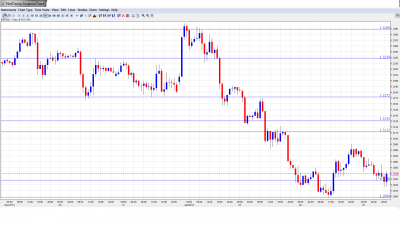The EUR/USD is steady as we begin the new trading week. The pair has leveled off after last week’s sharp slide, and remains above the important 1.30 line. On Friday, US employment numbers did not bring any surprises, while ISM Non-Manufacturing came in well above the estimate. There are only two releases on Monday, both out of Europe. Eurozone Sentix Investor Confidence posted another decline, but improved nicely, posting its best level since July 2011. Eurozone PPI declined by -0.2%, which was within market expectations.
EUR/USD Technical
- Asian session: Euro/dollar edged higher, and consolidated at 1.3050. The pair is slightly lower in the European session.
- Current range: 1.3030 to 1.3110.
Further levels in both directions:
- Below: 1,3030, 1.30, 1.2960, 1.2880, 1.28, 1.2750, 1.2690, 1.2624, 1.2590, 1.25 and 1.2440.
- Above: 1.3110, 1.3130, 1.3170, 1.3240, 1.3290, 1.3350, 1.34 and 1.3480.
- On the downside. 1.3030 remains under pressure. The next support line is 1.30.
- 1.3110 is providing strong resistance on the upside.
Euro/dollar steady following US employment data – click on the graph to enlarge.
EUR/USD Fundamentals
- 9:30 Eurozone Sentix Investor Confidence. Exp. -13.7 points. Actual -7.0 points.
- 10:00 Eurozone PPI. Exp. -0.1%. Actual -0.2%.
For more events and lines, see the Euro to dollar forecast
EUR/USD Sentiment
- Markets shrug off US data: Friday’s US employment numbers brought no surprises. Non-Farm Employment Change rose to 155 thousand, which was slightly above the estimate of 150K. The Unemployment Rate edged up from 7.7% to 7.8%. However, the November rate was revised to 7.8%, so there was actually no change. ISM Non-Manufacturing climbed to 56.1 points, its best reading since March. This easily beat the estimate of 54.2 points. This solid release has not affected EUR/USD, as the euro remains steady in Monday’s trading.
- Euro steady after sharp losses: As we begin a new week, the euro has managed to stop last week’s sharp drop. The pair initially jumped after the fiscal cliff agreement early last week as it took advantage of broad dollar weakness. The euro climbed very close to 1.33, and it looked like the greenback might continue to take a beating. However, the rally turned out to be very short-lived, and the euro has since dropped close to the significant 1.30 line. What caused the rally to snuff out so quickly? With the fiscal cliff behind us, at least for a bit, the markets refocused on Euro-zone data, and gave a thumbs down to some soft PMI numbers out of the EZ. The release of the minutes of the December FOMC meeting also made the markets nervous, as some members called for QE4 to end in 2013. As quantitative easing is dollar-negative, the possibility of an early end to the easing is bullish for the dollar.
- Fiscal cliff averted, for now: Following the last-minute agreement on the fiscal cliff, the markets breathed a collective sigh of relief. However, the euphoria could be short-lived, as the deal fails to deal with two critical issues – the debt ceiling and spending cuts. The debt ceiling will be reached in February, and action will have to be taken to avoid a default on the country’s debt. Republicans are expected to demand cuts in programs such as Medicare and Social Security, while the Democrats vehemently oppose any reductions in these programs, and favor raising the debt ceiling, which is what Congress agreed to in 2011. The IMF has also weighed in, saying that the fiscal agreement does not go far enough and that the US must take further action to deal with its long-term debt problem.
- Eurozone Debt Crisis takes toll on bank lending: The Eurozone debt crisis has had a major impact on the continent’s banking sector. This dire situation has led to a sharp drop in the amount of bank loans to private households. Such loans dropped by 0.8% in November compared to a year ago, after a similar decline in October. The ECB is clearly worried, and blames this trend on weak confidence in the Eurozone economy and increased aversion to risk. Analysts expect credit demand to continue to be weak, and note that the ECB’s decision to cut its deposit rate to zero percent has not boosted bank lending to the private sector. On the flip side, the Eurozone M3 indicator, which measures the amount of money in circulation, jumped by 3.8% in November. This could be an indication that more inflation is on the way in 2013, which could affect interest rates and the value of the euro.

